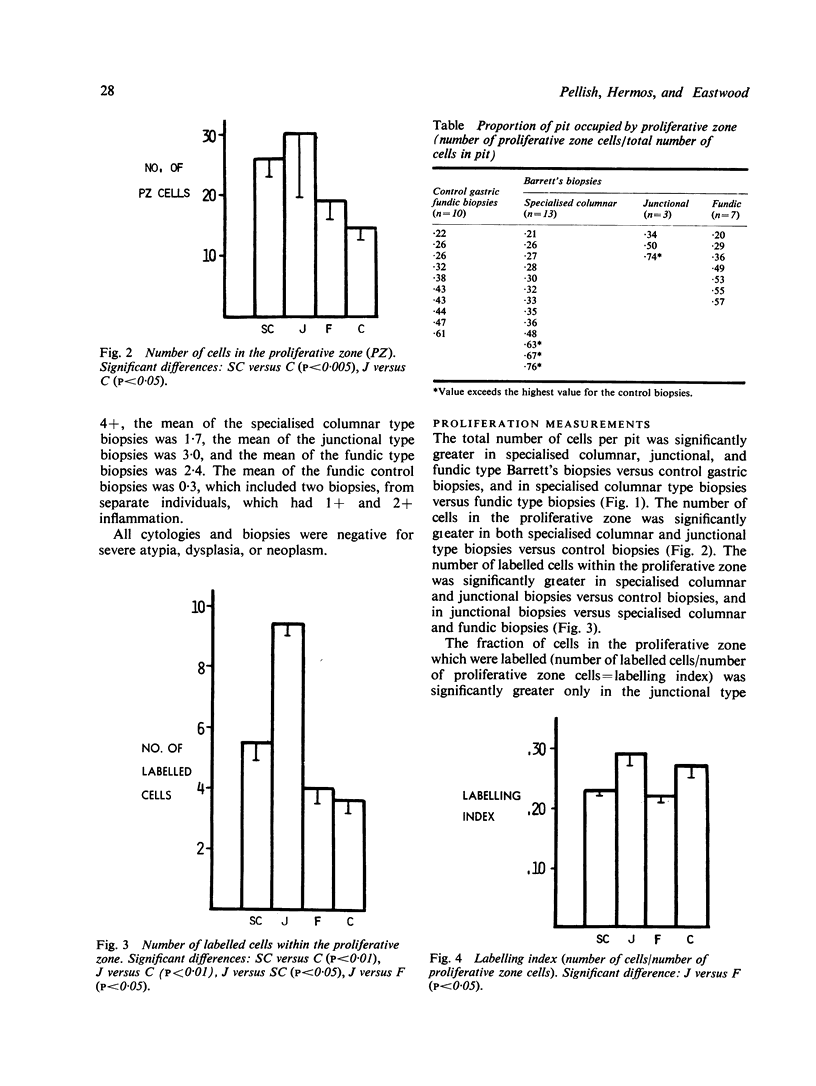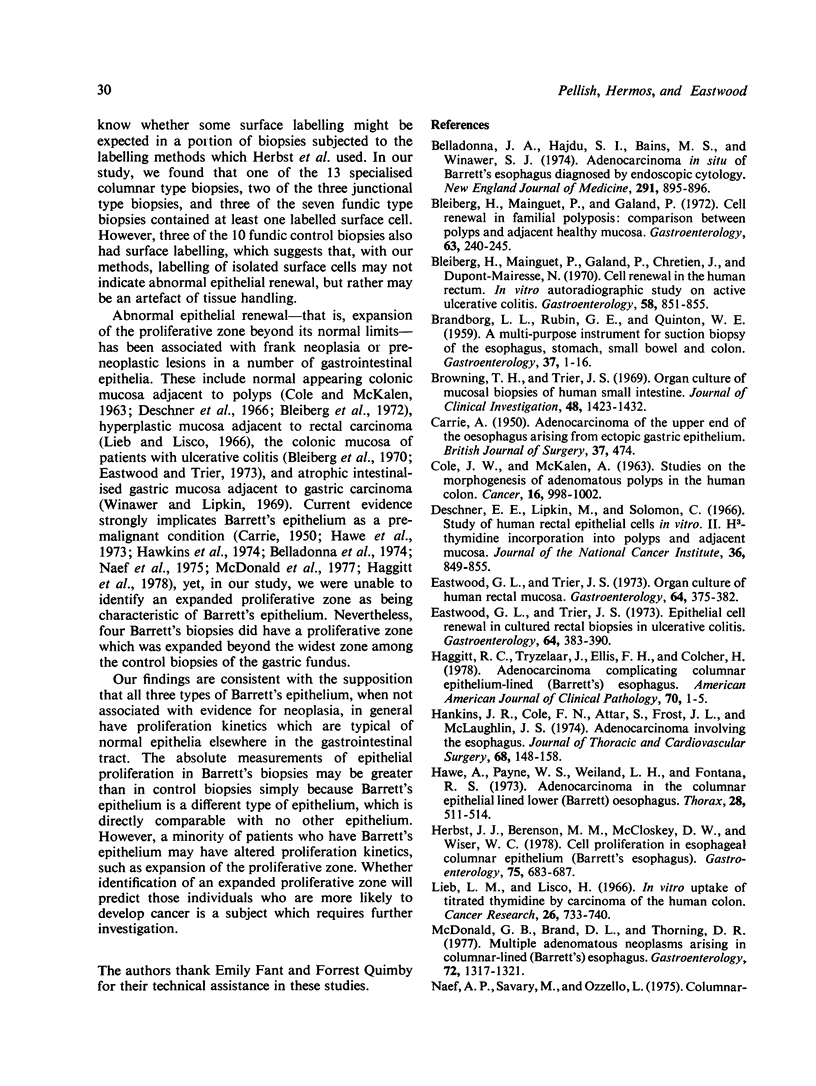Abstract
Barrett's epithelium is a columnar, possibly premalignant, metaplasia of the oesophagus. To study the pattern of epithelial renewal in this disorder, we localised the lower oesophageal sphincter by manometry in 12 patients with known Barrett's epithelium, obtained multiple suction biopsies above the sphincter, and organ cultured the biopsies over 3H-TdR-containing medium to label proliferating cells. Of 23 biopsies from the 12 patients, 13 were specialised columnar type, three were junctional type, and seven were fundic type. None of the patients showed clinical evidence of oesophageal carcinoma, and oesophageal cytological examinations were uniformly negative for neoplastic cells. When compared with control gastric fundic biopsies from normal volunteers, mean values for the labelling index and the proportion of the pit which was occupied by the proliferative zone in Barrett's biopsies were not significantly different. However, four individual Barrett's biopsies (three specialised columnar type and one junctional type) did have a proliferative zone which occupied a greater proportion of the pit than did the widest control zone. We propose that the pattern of epithelial proliferation in Barrett's epithelium in general is similar to that found in other gastrointestinal columnar epithelia. However, a minority of patients with Barrett's epithelium may have an expanded proliferative zone. The clinical implications of an expanded proliferative zone with regard to the subsequent development of oesophageal carcinoma require further investigation.
Full text
PDF





Selected References
These references are in PubMed. This may not be the complete list of references from this article.
- BRANDBORG L. L., RUBIN G. E., QUINTON W. E. A multipurpose instrument for suction biopsy of the esophagus, stomach, small bowel, and colon. Gastroenterology. 1959 Jul;37(1):1–16. [PubMed] [Google Scholar]
- Belladonna J. A., Hajdu S. I., Bains M. S., Winawer S. J. Adenocarcinoma in situ of Barrett's esophagus diagnosed by endoscopic cytology. N Engl J Med. 1974 Oct 24;291(17):895–896. doi: 10.1056/NEJM197410242911709. [DOI] [PubMed] [Google Scholar]
- Bleiberg H., Mainguet P., Galand P. Cell renewal in familial polyposis: comparison between polyps and adjacent healthy mucosa. Gastroenterology. 1972 Aug;63(2):240–245. [PubMed] [Google Scholar]
- Bleiberg H., Mainguet P., Galand P., Chretien J., Dupont-Mairesse N. Cell renewal in the human rectum. In vitro autoradiographic study on active ulcerative colitis. Gastroenterology. 1970 Jun;58(6):851–855. [PubMed] [Google Scholar]
- Browning T. H., Trier J. S. Organ culture of mucosal biopsies of human small intestine. J Clin Invest. 1969 Aug;48(8):1423–1432. doi: 10.1172/JCI106108. [DOI] [PMC free article] [PubMed] [Google Scholar]
- CARRIE A. Adenocarcinoma of the upper end of the oesophagus arising from ectopic gastric epithelium. Br J Surg. 1950 Apr;37(148):474–474. doi: 10.1002/bjs.18003714810. [DOI] [PubMed] [Google Scholar]
- COLE J. W., MCKALEN A. STUDIES ON THE MORPHOGENESIS OF ADENOMATOUS POLYPS IN THE HUMAN COLON. Cancer. 1963 Aug;16:998–1002. doi: 10.1002/1097-0142(196308)16:8<998::aid-cncr2820160806>3.0.co;2-c. [DOI] [PubMed] [Google Scholar]
- Eastwood G. L., Trier J. S. Epithelial cell renewal in cultured rectal biopsies in ulcerative colitis. Gastroenterology. 1973 Mar;64(3):383–390. [PubMed] [Google Scholar]
- Eastwood G. L., Trier J. S. Organ culture of human rectal mucosa. Gastroenterology. 1973 Mar;64(3):375–382. [PubMed] [Google Scholar]
- Haggitt R. C., Tryzelaar J., Ellis F. H., Colcher H. Adenocarcinoma complicating columnar epithelium-lined (Barrett's) esophagus. Am J Clin Pathol. 1978 Jul;70(1):1–5. doi: 10.1093/ajcp/70.1.1. [DOI] [PubMed] [Google Scholar]
- Hankins J. R., Cole F. N., Attar S., Frost J. L., McLaughlin J. S. Adenocarcinoma involving the esophagus. J Thorac Cardiovasc Surg. 1974 Jul;68(1):148–158. [PubMed] [Google Scholar]
- Hawe A., Payne W. S., Weiland L. H., Fontana R. S. Adenocarcinima in the columnar epithelial lined lower (Barret) oesophagus. Thorax. 1973 Jul;28(4):511–514. doi: 10.1136/thx.28.4.511. [DOI] [PMC free article] [PubMed] [Google Scholar]
- Herbst J. J., Berenson M. M., McCloskey D. W., Wiser W. C. Cell proliferation in esophageal columnar epithelium (Barrett's esophagus). Gastroenterology. 1978 Oct;75(4):683–687. [PubMed] [Google Scholar]
- Lieb L. M., Lisco H. In vitro uptake of tritiated thymidine by carcinoma of the human colon. Cancer Res. 1966 Apr;26(4):733–740. [PubMed] [Google Scholar]
- McDonald G. B., Brand D. L., Thorning D. R. Multiple adenomatous neoplasms arising in columnarlined (Barrett's) esophagus. Gastroenterology. 1977 Jun;72(6):1317–1321. [PubMed] [Google Scholar]
- Naef A. P., Savary M., Ozzello L. Columnar-lined lower esophagus: an acquired lesion with malignant predisposition. Report on 140 cases of Barrett's esophagus with 12 adenocarcinomas. J Thorac Cardiovasc Surg. 1975 Nov;70(5):826–835. [PubMed] [Google Scholar]
- Paull A., Trier J. S., Dalton M. D., Camp R. C., Loeb P., Goyal R. K. The histologic spectrum of Barrett's esophagus. N Engl J Med. 1976 Aug 26;295(9):476–480. doi: 10.1056/NEJM197608262950904. [DOI] [PubMed] [Google Scholar]
- Trier J. S., Browning T. H. Epithelial-cell renewal in cultured duodenal biopsies in celiac sprue. N Engl J Med. 1970 Dec 3;283(23):1245–1250. doi: 10.1056/NEJM197012032832302. [DOI] [PubMed] [Google Scholar]
- Winawer S. J., Lipkin M. Cell proliferation kinetics in the gastrointestinal tract of man. IV. Cell renewal in the intestinalized gastric mucosa. J Natl Cancer Inst. 1969 Jan;42(1):9–17. [PubMed] [Google Scholar]


